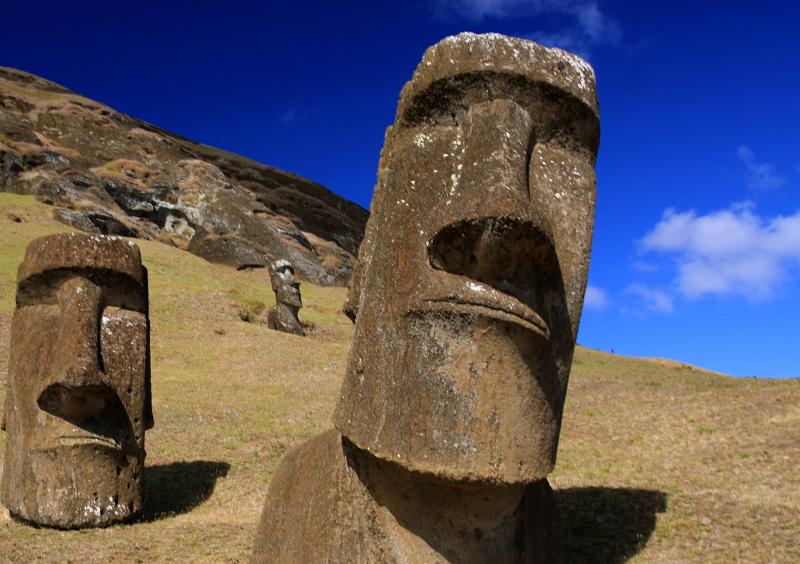
Barely 10 miles across at its widest and mostly devoid of trees, the most striking feature of Easter Island (Rapa Nui) is the hundreds of enormous stone statues, known as moai, scattered around the island. Nearly all of the moai are carved from the same stone: a volcanic tuff found in Rano Raraku, one of the lower craters of the Terevaka volcano which forms the bulk of Easter Island.
The moai are stylized human figures, created to be the living faces of deified ancestors. More than half the statues were transported from the quarry to the coast, where they rest on enormous stone platforms called Ahu, facing inland and watching over the island.
The remainder of the moai stand on the slopes of Rano Raraku. There are 21 within the quarry itself, one of which is carved with petroglyphs. Carvings are a rarity among Easter Island’s moai, which signifies the quarry’s importance (the other carved moai is in Orongo, a major ceremonial site). There could be a few reasons for this: Rano Raraku is the site of one of three freshwater lakes on the island, and the nearly exclusive use of volcanic tuff stone from the Rano Raraku quarry suggests the place itself was considered sacred.
UCLA’s Jo Anne Van Tilburg, director of the Rock Art Archive, worked with Cristián Arévalo Pakarati, a native Rapa Nui artist and illustrator, along with other members of the local community, in a multi-year excavation of two of the moai within the quarry. With the help of Sewanee Associate Professor of Earth and Environmental Systems Sarah Sherwood and Bryn Mawr Assistant Professor of Anthropology Casey Barrier, the researchers analyzed soil chemistry, plant fragments, and soil stratification to better understand indigenous land use and create a timeline of events in the quarry. Their research appeared in the November 2019 Journal of Archeological Science.
Easter Island was discovered and settled by people from Eastern Polynesia between 900 and 1100 A.D. The settlers, called the Rapa Nui, started producing moai almost immediately, and the number, size, and uniformity of the moai suggest the carvers belonged to an elite social class. Food production on the island consisted of fishing, chicken farming, and intensive gardening, but deforestation, heavy winds, and low rainfall caused major erosion and soil nutrient depletion, which severely limited opportunities for agriculture.
Here’s the interesting part: it was previously assumed that the quarry existed solely as an industrial site, but the study found that starting in roughly 1400 A.D, the quarry was also a major agricultural zone. Carving the moai caused pieces of tuff to be embedded in the soil, which significantly enriched it with phosphorus, potassium, and other crucial minerals. The Rapa Nui grew sweet potato, banana, taro, paper mulberry, and bottle gourd in the quarry with significantly higher crop yields than the rest of the island, and with much lower labor needs.
What’s more, the researchers posit that the Rano Raraku soil itself was a valuable and protected resource, and could very well have been transported from Rano Raraku to enrich other areas in need of increased productivity. Because of this kind of extensive resource trading, areas previously thought to be incapable of even supporting populations might have been able to prosper.
Says Barrier, “Overall, this research gives a more complex picture of sociopolitics and land use because it shows that the moai statue production and ritual activities involving them were related to agricultural productivity, soil fertility, and concerns over conservation.”